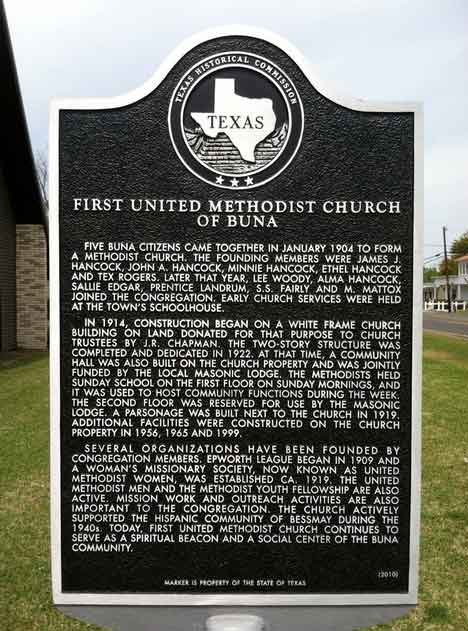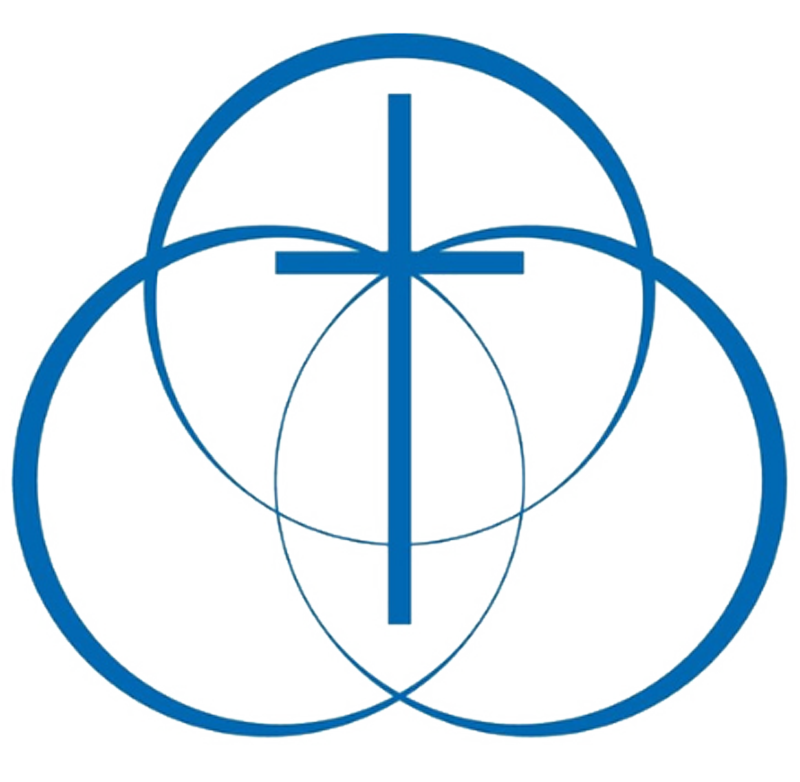Church History
CELEBRATING OVER 100 YEARS OF METHODISM IN BUNA, TEXAS
A Member of the Trinity Conference of Global Methodist Churches
A Brief History of
Buna Methodist Church
Among the early settlers in the piney woods of Jasper Co. Texas, came the Methodists. Of special interest to us is the pioneer beginnings of the Methodist Church in Buna. How did it get started? Research among some of our older members and friends has given us this brief historical picture.
It was in the Spring of 1906 that the founders of First Methodist Church met in the auditorium of the “old” Buna School. The congregation had Mr. Jim Hancock ask the “Presiding Elder” (District Superintendent) for a preacher. The first preacher to come was an old circuit rider, Rev. P. I. Milton, who preached once a month. Mts. Ethel Hargrove of Kountze remembers well how “we sat at school desks in the brand new two-room schoolhouse. We sang out of shaped note song books and we had an organ. Brother Milton would preach. He wasn’t what you would call a shouting Methodist. He was the kind who took a text and preached.” Since Euna was on the Silsbee Circuit in those days, the preacher would usually ride the train in from Silsbee on Saturday, spend the weekend and leave on Monday. He would usually alternate his stays between the Hancock home and the J. I. Mixson home. After Rev. Milton came the Rev. J. B. Gregory, Rev. W. H. Summy and Rev. I. B. Manley. The Rev. 0. W. Hooper was appointed and during his ministry, a white frame Church was built in 1914. A new parsonage was built next to the Church in 1919 for the first fulltime pastor, Rev. R. R. Smith, who arrived with his family in 1920. Buna was in the Silsbee-Buna Circuit; the Newton-Buna Circuit until 1912 and the Buna-Deweyville Circuit until 1926. The Church building was dedicated in 1922 by Bishop John M. Moore, during the pastorate of Rev. C. L. Williams. The Church was built on land donated for that purpose by the Kirby Lumber Company.
The Town in which it was located was a logging camp which supplied the Bessmay Saw Mill. At first, the church met once a month and then twice a month; then full time. It was Mrs. R. R. Smith who organized the first W.S.C.S. or The Woman’s Missionary Society, as it was then known.
In 1922, a Community Hall was erected on the Church property. It was a joint project between the Missionary Society of Buna Methodist Church and the Masonic Lodge. Old timers smile as they recall how they held chili and chicken suppers and domino parties to defray the expense. Their children went out to sell peanuts and popcorn. Among these were children from pioneer Buna families the Mixsons, the Hancocks, and the Gunters. The Methodist Church School met in the Community Hall mornings and the Baptists met there in the evenings. This hall was removed in the 1950’s and in 1957 the present Youth Building was erected.
In February of 1960, Mrs. B. A. Mitchael gifted the church additional property next to the existing parsonage which will aid the church in its future expansion program. About this time the church chimes were given by Mr. and Mrs. H. W. Mattox.
Many fine pastors came with the years-all making their contribution to the church and the community. Slowly and steadily the church advanced to a present membership of 329. Less than three years ago under the leadership of the pastor James Tunnell, a building committee was set up and an architect secured to design and prepare the plans for a new sanctuary. At the end of this same year Reverend Tunnell moved to another pastorate and the Reverend Robert Koch came as the new pastor. Under his leadership the plans presented by the architect, Mr. Rex Goode, were accepted by the building committee, and a financial plan was set up to secure and build the building. Before this could be completed, another Annual Conference came, and with it came a new pastor, Reverend Robert 0. Dean. In July of 1964 a dream of all the membership of the church came true when ground was broken for the new sanctuary. The following month the building was started, and the construction was watched by all in eager anticipation. Finally the day came to open and be in for the first service. It was quite a day as the congregation walked in and in awe saw a building that expressed all of our feelings to God in its glory and beauty.
This new building could not have all of its grace and beauty unless a little of the past could be remembered. The bell which graced the old church has been placed in a tower of the new church sign. This will help us to remember that all this was not done by us, but by those of the past as well. This bell was brought to Texas in 1889 from Louisiana and put to use on the “Dinky Train”. Then “Uncle Billy” Richardson secured the bell and in turn placed the bell at the church. “Uncle Billy” rang this bell for some 45 years.
Many gifts have been given. as memorials to the church in memory of loved ones, and those names have been placed in the Book of Memorials that is kept in the Registry in the church narthex.
This is just a brief peek into the past and present, and its splendid future is yet to be written. You will help write the next exciting chapter.

A Note From the Church Architect
A church building should be designed in terms of the function of the church and the particular congregation. The building should take on the nature of a symbol saying to the world something of what the church believes. Churches built today are for tomorrow, and the form of expression must fit the tomorrow.
The Church has a greater purpose than just to provide a place in which to hold services. Every day it must speak; even when there is no sermon to be heard or anthem to be listened to, it must speak itself-it must turn a visitor into a worshipper.
Space is our most valid symbol of God. The Christian faith must become manifest in brick, concrete, glass, wood and steel. The building must suggest that the Church is a people with a history whose work is in the present the now that will be the history of tomorrow-and whose destiny is beyond history and this life.
Buildings for the use of the Church are not ends in themselves; they are tools in the hands of a congregation for the work of the Lord. Their plan and design must be reasoned in terms of the congregation and the task they are to accomplish.
The interior must express a churchliness, a mood for worship, a quality which induces reverence-there must be something distinctive about it. It is not just another auditorium; It is a sanctuary, a holy place. It is the House of God.
In the Methodist Church, definite emphasis is placed on the mean of grace: the Word and two sacraments, Baptism and the Lord’s Supper. Hence, prominence is given to the pulpit as well as altar and font.
The Communion Table is the chief focal point in this church. It is given a place of commanding interest. All lines converge toward this. Nothing obstructs the view, neither pulpit, lectern, organ console, nor choir. The reredos is simple so as not to detract from the altar, but to accent it-curved to reflect the spoken word. The lighting has been designed to provide pleasant and sufficient lighting to read and worship by. Both accent lighting and indirect lighting have been provided, with dimmer switches to control the level of brightness for all phases of the worship service.
Surfaces are as acoustically reflective as possible to achieve optimum distribution of reflected sound and good natural reinforcement of speech and music. The balcony facing is treated so as to absorb sound-thus preventing “feed-back” and providing good hearing conditions and a satisfactory acoustical environment.
There is no ideal religious building for our time, either for a faith or a given region. But there is an ideal building for every congregation, to meet its particular needs. The congregation alone can decide what the building should do. It is the architect’s task to create that quality of space which inspires reverence and ·makes the building a valid symbol of our faith.
We sincerely hope that this has been accomplished here.
Rex Goode, A.I.A. Architect
